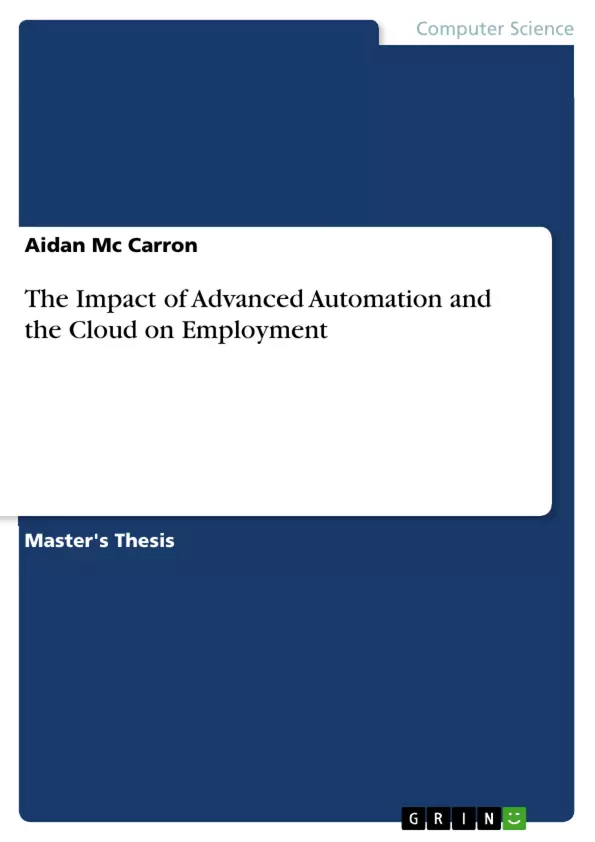One of the primary fears in the current global community is the exponential growth and continued sophistication of artificial intelligence. Fundamental to this concern is the wide ranging impact that this growth will not only leave on the world as we currently know it, but on the place of humans in that world. This has become termed as ‘the singularity’—the point in time when machines will become self-learning, and more importantly, self-aware.
It is at this point that machines and robotics will be elevated from the current monotonous job operations to more high skilled areas. This study looks into the drive towards advanced automation and the increased sophistication of artificial intelligence in conjunction with the cloud and how this growth will eventually lead to technological unemployment.
Some economists are predicting up to a 50% job loss or more. Predicting the future typically means extrapolating the past. It often fails to anticipate breakthroughs. But it is precisely those unpredictable breakthroughs in computing that could have the biggest impact on the workforce. Education and up skilling current workers will be the only way to ensure continued relevance within an automated workforce. By focusing on education it will ensure people are best placed to take advantage of this new age of advanced automation. This dissertation concludes that innovation through creativity will ensure employment opportunities continue to present themselves to those best prepared for such changes.
Inhaltsverzeichnis (Table of Contents)
- 1. INTRODUCTION
- 1.1 Background and Context
- 1.2 Research Question
- 1.3 Value of Research
- 1.4 Scope and Boundaries of this Study
- 1.5 Chapter Roadmap
- 2. LITERATURE REVIEW
- 2.1 Introduction
- 2.2 Sources
- 2.3 The Cloud and Advanced Automation
- 2.3.1 Data Centre and the Cloud
- 2.4 Technological Unemployment
- 2.5 Impact of Automation on Employment
- 2.5.1 Outsourcing Vs. Automation
- 2.6 What is the Singularity?
- 2.7 Projected Timeline for the Singularity
- 2.7.1 Moore's Law
- 2.7.2 Storage
- 2.7.3 Supercomputers
- 2.8 Conclusion
- 3. RESEARCH METHODOLOGY
- 3.1 Introduction
- 3.2 Purpose of Research
- 3.3 Research Philosophy
- 3.3.1 Pragmatism
- 3.3.2 Positivism
- 3.3.3 Realism
- 3.3.4 Interpretivism
- 3.4 Research Strategy
- 3.4.1 Online Survey
- 3.4.2 Data Collection
- 3.4.3 Case Study
- 3.5 Survey Tool
- 3.6 Participant Demographic
- 3.7 Conclusions
- 4. FINDINGS AND ANALYSIS
- 4.1 Introduction
- 4.2 Data Analysis
- 4.3 Survey Results
- 4.3.1 Advanced Automation
- 4.3.2 Cloud Services
- 4.3.3 Data Centre
- 4.3.4 Employment in IT
- 4.4 Dediserve: A Case Study
- 4.4.1 Introduction
- 4.4.2 Employment and Automation
- 4.5 Summary of Findings
- 5. Conclusions
- 5.1 Introduction
- 5.2 Will Advanced Automation Impact Employment?
- 5.3 Occupations Under Threat
- 5.4 A Future with Advanced Automation
- 5.5 Limitations
- 5.6 Future Research Opportunities
- 5.7 Summary
Zielsetzung und Themenschwerpunkte (Objectives and Key Themes)
This dissertation investigates the impact of advanced automation and the cloud on employment. It explores the potential for technological unemployment as artificial intelligence continues to advance and how this growth will affect the workforce.- The impact of advanced automation and the cloud on the future of employment.
- The potential for technological unemployment due to advancements in artificial intelligence.
- The role of education and upskilling in preparing the workforce for the age of automation.
- The influence of cloud computing on employment trends and opportunities.
- The potential implications of the technological singularity for the workforce.
Zusammenfassung der Kapitel (Chapter Summaries)
- Chapter 1 introduces the topic of the dissertation, outlining the research question, value, scope, and chapter roadmap.
- Chapter 2 delves into a comprehensive literature review, examining the relationship between advanced automation, cloud computing, and technological unemployment. It explores concepts such as the singularity and Moore's Law, and analyzes the impact of automation on various sectors.
- Chapter 3 outlines the research methodology employed, including the research philosophy, strategy, data collection methods, and participant demographics.
- Chapter 4 presents the findings and analysis of the research, covering data analysis and survey results. It also includes a case study examining Dediserve's approach to employment and automation.
- Chapter 5 presents the conclusions drawn from the research, addressing the impact of advanced automation on employment, identifying occupations at risk, and exploring the future of the workforce in an automated world.
Schlüsselwörter (Keywords)
The primary keywords and focus topics of this dissertation revolve around the relationship between technological advancements, specifically in the realms of artificial intelligence, cloud computing, and advanced automation, and their subsequent impact on the future of employment. Key themes include technological unemployment, the singularity, workforce preparedness, education and upskilling, and the influence of cloud services on employment trends.- Quote paper
- Aidan Mc Carron (Author), 2015, The Impact of Advanced Automation and the Cloud on Employment, Munich, GRIN Verlag, https://www.grin.com/document/436754



